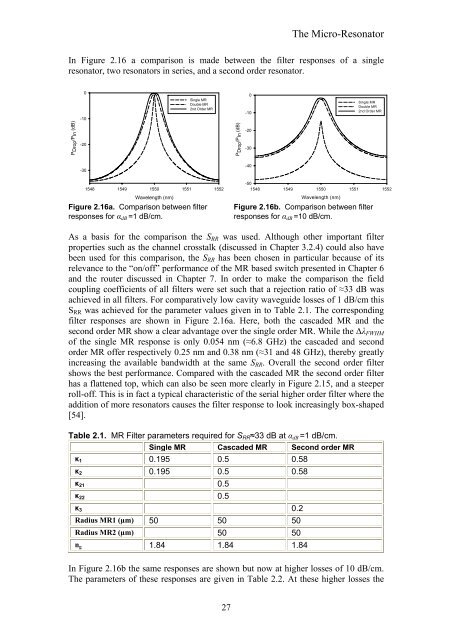Edwin Jan Klein - Universiteit Twente
Edwin Jan Klein - Universiteit Twente
Edwin Jan Klein - Universiteit Twente
You also want an ePaper? Increase the reach of your titles
YUMPU automatically turns print PDFs into web optimized ePapers that Google loves.
27<br />
The Micro-Resonator<br />
In Figure 2.16 a comparison is made between the filter responses of a single<br />
resonator, two resonators in series, and a second order resonator.<br />
P Drop /P In (dB)<br />
0<br />
-10<br />
-20<br />
-30<br />
Single MR<br />
Double MR<br />
2nd Order MR<br />
1548 1549 1550<br />
Wavelength (nm)<br />
1551 1552<br />
Figure 2.16a. Comparison between filter<br />
responses for αdB =1 dB/cm.<br />
P Drop /P In (dB)<br />
0<br />
-10<br />
-20<br />
-30<br />
-40<br />
-50<br />
1548 1549 1550 1551 1552<br />
Wavelength (nm)<br />
Single MR<br />
Double MR<br />
2nd Order MR<br />
Figure 2.16b. Comparison between filter<br />
responses for αdB =10 dB/cm.<br />
As a basis for the comparison the SRR was used. Although other important filter<br />
properties such as the channel crosstalk (discussed in Chapter 3.2.4) could also have<br />
been used for this comparison, the SRR has been chosen in particular because of its<br />
relevance to the “on/off” performance of the MR based switch presented in Chapter 6<br />
and the router discussed in Chapter 7. In order to make the comparison the field<br />
coupling coefficients of all filters were set such that a rejection ratio of ≈33 dB was<br />
achieved in all filters. For comparatively low cavity waveguide losses of 1 dB/cm this<br />
SRR was achieved for the parameter values given in to Table 2.1. The corresponding<br />
filter responses are shown in Figure 2.16a. Here, both the cascaded MR and the<br />
second order MR show a clear advantage over the single order MR. While the ∆λFWHM<br />
of the single MR response is only 0.054 nm (≈6.8 GHz) the cascaded and second<br />
order MR offer respectively 0.25 nm and 0.38 nm (≈31 and 48 GHz), thereby greatly<br />
increasing the available bandwidth at the same SRR. Overall the second order filter<br />
shows the best performance. Compared with the cascaded MR the second order filter<br />
has a flattened top, which can also be seen more clearly in Figure 2.15, and a steeper<br />
roll-off. This is in fact a typical characteristic of the serial higher order filter where the<br />
addition of more resonators causes the filter response to look increasingly box-shaped<br />
[54].<br />
Table 2.1. MR Filter parameters required for SRR≈33 dB at αdB =1 dB/cm.<br />
Single MR Cascaded MR Second order MR<br />
κ1 0.195 0.5 0.58<br />
κ2 0.195 0.5 0.58<br />
κ21 0.5<br />
κ22 0.5<br />
κ3 0.2<br />
Radius MR1 (µm) 50 50 50<br />
Radius MR2 (µm) 50 50<br />
ng 1.84 1.84 1.84<br />
In Figure 2.16b the same responses are shown but now at higher losses of 10 dB/cm.<br />
The parameters of these responses are given in Table 2.2. At these higher losses the















